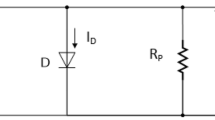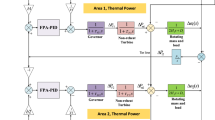Abstract
This work presents a methodology to estimate solar irradiance using Kalman filter for systems with unknown inputs, an approach more adequate to system characteristics than the standard formulation of this tool. A system with photovoltaic panel, dc–dc converter and load was modeled and simulated in order to analyze the proposed methodology in situations of clear, almost clear and cloudy sky days. The proposed estimator and an analytical method are compared with respect to the ability to compute the irradiance and tested against uncertainties in modeling parameters and noise in the voltage and current measurements of the system. The results show that, through a single sensor, the developed methodology allows to estimate and filter not only solar irradiance, but also output current of photovoltaic system and output voltage of converter. This brings benefits in reducing costs with sensors, allows real-time measurements and avoids propagating noisy measures in the management of a solar system.











Similar content being viewed by others
Notes
For discretization, using usual state space discretization method with sampling time \( T_{\mathrm {s}}\), system is rewritten with input matrix defined as \(\left[ \mathcal {G} \mathcal {E}\right] \) and resultant matrix is separated in G and E.
References
Bright, J. M., Killinger, S., Lingfors, D., & Engerer, N. A. (2018). Improved satellite-derived PV power nowcasting using real-time power data from reference PV systems. Solar Energy, 168, 118–139.
Camacho-Solorio, L., & Sariñana-Toledo, A. (2014). I-LQG control of DC-DC boost converters. In: 2014 11th International conference on electrical engineering, computing science and automatic control CCE 2014.
Chikh, A., & Chandra, A. (2015). An optimal maximum power point tracking algorithm for PV systems with climatic parameters estimation. IEEE Transactions on Sustainable Energy, 6(2), 644–652.
Chu, Y., Pedro, H. T. C., Li, M., & Coimbra, C. F. M. (2015). Real-time forecasting of solar irradiance ramps with smart image processing. Solar Energy, 114, 91–104.
Darouach, M., Zasadzinski, M., Onana, A. B., Nowakowski, S., Bassong, O. A., & Nowakowski, S. (1995). Kalman filtering with unknown inputs via optimal state estimation of singular systems. International Journal of Systems Science, 26(10), 2015–2028.
Ding, F., Member, S., & Loparo, K.A. (2015). Dynamic modeling and stability analysis of grid-connected and autonomous distributed generation system. In: 2015 IEEE Power & Energy Society Innovative Smart Grid Technologies Conference (ISGT) (Vol. 2, pp. 1–5). https://doi.org/10.1109/ISGT.2015.7131896
Erickson, R. W., & Maksimović, D. (2001). Fundamentals of power electronics. Boston: Springer US.
Hsieh, C. S. (2000). Robust two-stage Kalman filters for systems with unknown inputs. IEEE Transactions on Automatic Control, 45(12), 2374–2378.
Kalman, R. E. (1960). A new approach to linear filtering and prediction problems. Journal of Basic Engineering, 82(1), 35.
Kurucso, B., Peschka, A., Stumpf, P., Nagy, I., & Vajk, I. (2016). State space control of quadratic boost converter using LQR and LQG approaches. In: Joint international conference—ACEMP 2015: Aegean conference on electrical machines and power electronics, OPTIM 2015: optimization of electrical and electronic equipment and electromotion 2015: international symposium on advanced electromechanical Moti (issue 2, pp. 642–648).
Laudani, A., Fulginei, F. R., Salvini, A., Carrasco, M., & Mancilla-David, F. (2016). A fast and effective procedure for sensing solar irradiance in photovoltaic arrays. In: EEEIC 2016—International Conference on Environment and Electrical Engineering (issue 3, pp. 0–3)
López del Moral, D., Barrado, A., Sanz, M., Lázaro, A., & Zumel, P. (2018). Analysis and implementation of the Buck–Boost modified series forward converter applied to photovoltaic systems. Solar Energy, 176, 771–787.
Martins, F. R., & Pereira, E. B. (2011). Estudo comparativo da confiabilidade de estimativas de irradiação solar para o sudeste brasileiro obtidas a partir de dados de satélite e por interpolação/extrapolação de dados de superfície. Revista Brasileira de Geofisica, 29(2), 265–276.
Miller, S. D., Rogers, M. A., Haynes, J. M., Sengupta, M., & Heidinger, A. K. (2018). Short-term solar irradiance forecasting via satellite/model coupling. Solar Energy, 168, 102–117.
Mohamed, A., & Mohammed, O. (2013). Real-time energy management scheme for hybrid renewable energy systems in smart grid applications. Electric Power Systems Research, 96, 133–143.
Molina, M.G. (2016). Modelling and control of grid-connected solar photovoltaic systems. In: Renewable energy—utilisation and system integration. InTech.
Moshksar, E., & Ghanbari, T. (2018). A model-based algorithm for maximum power point tracking of PV systems using exact analytical solution of single-diode equivalent model. Solar Energy, 162, 117–131.
National Institute for Space Research—INPE. (2018). National system of Ambiental data organization—SONDA
Nespoli, L., & Medici, V. (2017). An unsupervised method for estimating the global horizontal irradiance from photovoltaic power measurements. Solar Energy, 158, 701–710.
Nguyen, X. H., & Nguyen, M. P. (2015). Mathematical modeling of photovoltaic cell/module/arrays with tags in Matlab/Simulink. Environmental Systems Research, 4(1), 24.
Nouri, B., Wilbert, S., Segura, L., Kuhn, P., Hanrieder, N., Kazantzidis, A., et al. (2019). Determination of cloud transmittance for all sky imager based solar nowcasting. Solar Energy, 181, 251–263.
Pereira, E. B., Martins, F. R., Gonçalves, André Rodrigues, Costa, R. S., Lima, Francisco J., Lopes de Rüther, R., et al. (2017). Atlas Brasileiro de Energia Solar (2nd ed.). São José dos Campos: INPE.
Rosiek, S., Alonso-Montesinos, J., & Batlles, F. J. (2018). Online 3-h forecasting of the power output from a BIPV system using satellite observations and ANN. International Journal of Electrical Power and Energy Systems, 99, 261–272.
Scolari, E., Sossan, F., & Paolone, M. (2017). Photovoltaic-model-based solar irradiance estimators: performance comparison and application to maximum power forecasting. IEEE Transactions on Sustainable Energy, 9(1), 35–44. arXiv:1705.04132.
Scolari, E., Sossan, F., Haure-Touzé, M., & Paolone, M. (2018). Local estimation of the global horizontal irradiance using an all-sky camera. Solar Energy, 173, 1225–1235.
Tan, R. H. G., Tai, P. L. J., & Mok, V. H. (2013). Solar irradiance estimation based on photovoltaic module short circuit current measurement. In: IEEE international conference on smart instrumentation, measurement and applications (ICSIMA) (pp. 26–27)
Tewari, N., & Sreedevi, V. T. (2018). A novel single switch dc-dc converter with high voltage gain capability for solar PV based power generation systems. Solar Energy, 171, 466–477.
Tian, H., Mancilla-David, F., Ellis, K., Muljadi, E., & Jenkins, P. (2012). A cell-to-module-to-array detailed model for photovoltaic panels. Solar Energy, 86(9), 2695–2706.
Wang, P., van Westrhenen, R., Meirink, J. F., van der Veen, S., & Knap, W. (2019). Surface solar radiation forecasts by advecting cloud physical properties derived from Meteosat second generation observations. Solar Energy, 177, 47–58.
Acknowledgements
This study was financed in part by the Coordenação de Aperfeiçoamento de Pessoal de Nível Superior—Brasil (CAPES)—Finance Code 001.
Author information
Authors and Affiliations
Corresponding author
Additional information
Publisher's Note
Springer Nature remains neutral with regard to jurisdictional claims in published maps and institutional affiliations.
Appendix: Choice of V, W and \( P^x_{0|0} \)
Appendix: Choice of V, W and \( P^x_{0|0} \)
Two very important parameters of the KFUI are the values of V, W and \( P^x_{0|0} \). They are associated with the noises present in the state x and the output y.
To determine appropriate values for the parameters V, W and \( P^x_{0|0} \), some simulations were carried out replacing several values in these matrices using genetic algorithm (GA). The following minimization problem was applied
which correspond to the basic idea of a Kalman Filter: minimize the errors of \( {\hat{x}}_k \) with respect to a real value \( {x}_k \). For this, it was used MATLAB’s genetic algorithm with standard parameters.
Additionally, it is necessary to observe the behavior of unknown input estimation as
The sum (33) is not included in problem (32) because the tests were performed for both KFUI and SKF. The last one does not estimate the unknown input.
Figure 12 shows the convergences of J and \( J^z \) for the irradiance of Day 1. Each individual index is a set of V, W and \( P^x_{0|0} \) chosen by GA and evaluated for all values of the real irradiance in Fig. 3. It can be noted that KFUI estimations of \( {\hat{ {\tilde{x}}}_{k|k}} \) and \( {{\hat{ {\tilde{i}}}_{ph}}_{k|k + 1}} \) and, consequently, irradiance estimation are not affected by variations in the parameters V, W or \( P^x_{0|0} \). In Table 6, it can be observed that KFUI presents better estimate than SKF across all generations tested with the GA.
Thus, the parameters V, W and \( P^x_{0|0} \) should be chosen more carefully if SKF is used. On the other hand, for this application, any value that satisfies condition \( C_5 \) can be used in KFUI in order to result in optimal estimates for \( {\hat{ {\tilde{x}}}_{k|k}} \) and \( {{\hat{ {\tilde{i}}}_{ph}}_{k|k + 1}} \). For simplicity, it was used a KFUI with \( V = W = P^x_{0|0} = I \).
Rights and permissions
About this article
Cite this article
Madureira, V.S., das Chagas, T.P. & de Jesus, G.Q. Solar Irradiance Estimation Using Kalman Filter. J Control Autom Electr Syst 31, 1447–1457 (2020). https://doi.org/10.1007/s40313-020-00649-x
Received:
Revised:
Accepted:
Published:
Issue Date:
DOI: https://doi.org/10.1007/s40313-020-00649-x





